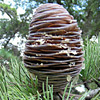Cedrus deodara is a high mountain tree that occurs in many locations from 1000 to 3000 m a.s.l. in the Himalaya. Its natural range spans parts of Afghanistan; Tibet, India (Himachal Pradesh, Jammu-Kashmir, Uttar Pradesh); Nepal; and Pakistan. It usually grows on silicate mother rocks. The best trees are found on deep, well-drained soils
Himalayan cedar was introduced to Europe and North America in the 19th century and soon became a favorite as an ornamental tree in large gardens and parks.
Cedrus deodara grows up to 50 m high and up to 3 m in diameter. Young trees have a broad pyramidal crown that becomes wider with age. Branches horizontally arranged, and end of the shoots pendulous. One-year shoots densely pubescent. Needles blue-green, 3-5 cm long, acuminate, occur singly on new growth and later about 30 in a cluster on spur shoots; remaining on the tree for 3 to 6 years. The bark is initially smooth and gray-brown, later developing short furrows with scaly ridge tops.
Like other members of the Pinaceae Cedrus deodara is monoecious with flowers arranged in male and female cones. The flowers appear in September and October. Male cones, 5-8 cm long grow on the lower parts of crown are cylindrical buds that sit upright on branches and change from green though pink to purple before shedding their pollen at the end of October. The female cones appear on upper portions of crown solitary or in pairs erect, ovate or barrel-shaped. 7-10 cm long, 5-6 cm wide, rounded at the apex, bluish when young, reddish-brown when ripe. They take a year to mature from September to December, at which point they disintegrate, shedding their seeds and leaving a central spike on the branch. The seed scales 5-6 cm wide, usually glabrous on the upper side. Seed are about 17 mm long, about 6 mm wide; with a large wing, light brown color.
Himalayan cedar is the national tree of Pakistan and the name deodar comes from the Sanskrit word 'devdar' which means 'timber of the gods'. It is perhaps unsurprising then that these huge trees (up to 75m tall in the wild) are used extensively for their timber in their countries of origin. The wood is strong, durable and fragrantly scented and as it has religious associations is typically used for construction in temples and palaces. It is also used for more mundane purposes such as for railways sleepers and in bridges, and the well-known houseboats of Srinagar, Kashmir.
The use of C. deodara in Ayurvedic medicines is well known. The plant yields a medicinal essential oil by distillation of the wood which is used for treatment of a wide range of ailments from fevers and dysentery, to bronchitis, and snake bites. A resin obtained from the wood is used externally to treat bruises, skin diseases and injuries to joints. The leaves are used in the treatment of tuberculosis. Oil obtained from the seed is applied externally to treat skin diseases.
The essential oil is used as insect repellent on the feet of horses, cattle and camels. It also has anti-fungal properties and has some potential for control of fungal deterioration of spices during storage. Due to its anti-fungal and insect repellent properties, rooms made of Cedrus deodara wood are used to store meat and food grains like oats and wheat in Himachal Pradesh. In Himachal people suffering from asthma or other respiratory problems are advised to sit under a Deodar tree early in the morning.
Cedar oil is often used for its aromatic properties, especially in aromatherapy. Its applications cover soap perfumes, household sprays, floor polishes and insecticides. It is also used in microscope work as a clearing oil.






